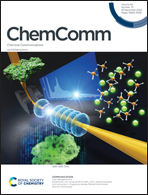Photocatalytic dechlorination of unactivated chlorocarbons including PVC using organolanthanide complexes†‡
Abstract
Simple lanthanide cyclopentadienyl (Cp) complexes can photochemically cleave the sp3 carbon–chlorine bond of unactivated chlorinated hydrocarbons including polyvinyl chloride (PVC). The excited state lifetimes of these simple complexes are among the longest observed for cerium complexes (175 ns for [(CpMe4)2Ce(μ-Cl)]2) and the light absorption by the Cp ligand is efficient, so photocatalytic reactivity is enhanced for cerium and now also made possible for neighboring, normally photoinactive, lanthanide congeners.

- This article is part of the themed collections: ChemComm 60th Anniversary Board Member Collection and Chemical Communications HOT Articles 2023


 Please wait while we load your content...
Please wait while we load your content...